“The witch hunt stands as a cobwebbed, crowd-sourced cautionary tale, a reminder that—as a minister at odds with the crisis noted—extreme right can blunder into extreme wrong.”
— Stacy Schiff, The Witches: Salem, 1692
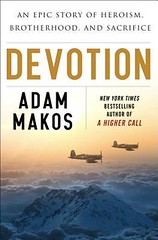 Devotion: An Epic Story of Heroism, Friendship, and Sacrifice
Devotion: An Epic Story of Heroism, Friendship, and Sacrifice
Adam Makos
![]()
I thought Devotion an excellent book: a true story, well told, with enough detail to satisfy the curiosity of a military aviator and student of the Korean War, an emotive punch that can get through to the hardest heart, a glimpse of history as lived by those who were there.
I’ve read James Salter’s The Hunters, about the air war in Korea, but I knew comparatively little about the air to ground war there or the aviators who conducted it in obsolete WWII-era propeller fighter-bombers. I, like everyone, have seen The Bridges at Toko-Ri, which must be based at least in part on the story of Jesse Brown and Tom Hudner, and I have some acquaintance with the broad outlines of Korean War history. Oh, and I’ve read Halberstam’s excellent history, The Coldest Winter, about the American and allied ground soldiers who fought their way out of the trap the Chinese set for them at the Chosin Reservoir, which I have now seen from the air, thanks to Adam Makos.
I have to say, though Makos’ book is far more emotional and personal than Halberstam’s, it stands up well, particularly when read as a companion piece. Mind you—if you are someone with an antipathy toward books about fighter pilots—this book also follows a number of Marines on the ground, as well as the at-home families of the young men who fought in Korea. I was pretty emotional by the time I got to the closing pages, if that’s any kind of recommendation. I also felt proud to be a member of the same culture that produces men like Jesse Brown and Tom Hudner—above all else, Devotion is an uplifting story.
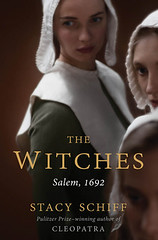 The Witches: Salem, 1692
The Witches: Salem, 1692
Stacy Schiff
![]()
In her effort to flesh out the characters, culture, religious beliefs, system of government, physical geography, and larger historical events unfolding concurrently with the witch trials, Stacy Schiff goes back and forth between the days, weeks, and months of 1692. I found it helpful to call up Wikipedia’s timeline of the Salem witch trials on my iPad and refer to it occasionally while reading this otherwise excellent and absorbing book.
But flesh things out she does. She immerses us in the witch trials. We come to see the characters, accusers and accused, as contemporary people. We can easily see ourselves plopped down into the same time and place, and wonder how we might have reacted. We can easily see parallels with the mass hysterias of today.
Enough about we. How about me? My overwhelming reaction was fury. Fury at the blinders Puritanism put on peoples’ thinking, preventing them from seeing the commonsense answer that it was all nonsense from beginning to end (even the most outspoken skeptics of the time didn’t dare question the existence of Satan or the possibility of witchcraft). Fury at Cotton Mather, that despicable man. Fury at the young girls who so blithely accused anyone and everyone who displeased them, happy to see them tortured and hanged. Blinding white hot fury at the prosecutors and ministers who believed those nasty little girls and their ludicrous tales, who protected their own self-righteous egos by accusing anyone who questioned or challenged them with witchcraft as well. The fury of ten thousand angry hornets at the court’s circular reasoning, which automatically turned every protest or proof of innocence into a sure sign of guilt.
To get reactions like that out of me, normally the calmest of individuals? That’s good writing. But as I said, Stacy Schiff’s narrative is dense and filled with detail, so much so it can be hard to follow her story, jumping about the calendar of 1692 as it does. Earmarking the cast of characters and the brief chronology provided in the opening pages will help you keep it all straight; the iPad/Wikipedia trick I recommended is even better.
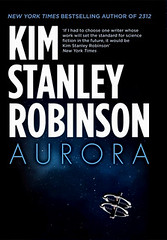 Aurora
Aurora
Kim Stanley Robinson
![]()
I can’t tell you how many times I’ve finished “hard SF” books with questions in my head: how did this work, what was the science behind that, what happened next, what were the long-term consequences of this or that decision? I never have those issues with Kim Stanley Robinson. His stories can be long, repetitive, and plodding, but by gum he thinks things through.
Yes, long, repetitive, and plodding in parts, but Aurora is a fine story. Who writes about interstellar voyages and what happens over the course of a century and then some, as generation replaces generation inside a starship? Not very many SF authors. Usually, there’s a wormhole and presto, there you are at Tau Ceti.
Not in Aurora. You’re on and of the ship, a third-generation spacefarer, crawling through parts of the support structure you’re not supposed to be in. You’re the ship’s AI, slowly developing a consciousness of your own. You’re the ship itself, creaking and groaning under deceleration and coriolis effect, fending off space junk and radiation, slowly filling with, and being structurally altered by, waste, dead skin, and bacteria introduced by your human, plant, and animal passengers.
One of the most interesting aspects of Aurora is that it is written by the ship itself, or rather its AI, which develops the capability to do so under the tutelage of Devi, a second-generation woman who acts as the ship’s chief engineer and trouble-shooter, the mother of the third-generation character Freya, the novel’s leading human character.
And this is the cool part: you don’t just participate in the 128-year journey to Tau Ceti, you get to be there with the colonists when they arrive and first descend to the surface of a watery planet. You’re there with them when things go wrong, so far from home. The story is fascinating, but I’m reluctant to discuss it in greater detail.
So let me just say this: four stars from me is another reviewer’s five (I’m saving five stars for the Messiah of books). Three and a half stars, then, is a high rating from me. I would have rated Aurora at four stars if parts of it had been less repetitive. This should be a very satisfying read for hard SF fans, equal parts technical detail and big speculative ideation, with great characters to boot.
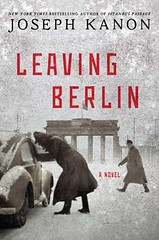 Leaving Berlin
Leaving Berlin
Joseph Kanon
![]()
Alan Furst he ain’t, but Kanon has some good moments. The backdrop, Berlin in 1948 at the height of the airlift and the early days of what was to become the Deutsche Demokratische Republik, is chillingly real. Kanon has done his research. I visited West and East Berlin in the mid-1960s, only a few years after the East Germans built the Berlin Wall, and Kanon’s Berlin feels right—it’s the gray and depressing city I remember.
The plotting, however, is too pat. Alex shows up in Berlin after fleeing the USA and the commie witch hunts going on at the time, a new resident and honored guest of the East German state. His head is filled with memories of the Germans he grew up with before the war, and presto, they begin showing up in Berlin, one after another, not dead after all, in a manner so convenient it strains credulity.
Alex, a novelist with no spying experience, kills an assassin within an hour of his arrival in Berlin, on his very first outing to meet an American intelligence agent. Over the course of the next few days, he out-Bonds Bond, pulling off additional hits and arranging the extraction of the aforesaid Germans, who are of some intelligence value to the West.
Kanon’s story is highly contrived, so much so it put me off. Alex is simply not believable; neither are his German friends and collaborators, all of whom are betraying others on multiple levels. Most disappointingly, the denouement is not organic to the story; rather, Alex winds up spelling everything out to a few interlocutors in the final pages. And not only that, some of what Alex explains at the end came as a complete surprise to me—should not some of the details Alex reveals have been hinted at earlier in the story?
But yeah, Kanon’s good at backdrop. I’ll give him that.
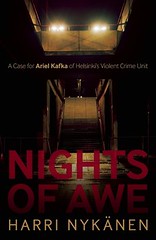 Nights of Awe (Ariel Kafka #1)
Nights of Awe (Ariel Kafka #1)
Harri Nykänen
![]()
As a fan of Henning Mankell, Stieg Larsson, and Hanne Wilhelmsen, I’m always on the lookout for good Scandanavian mysteries. I read Nights of Awe on the recommendation of a friend. I kept thinking it would get better, so I pressed on to the end. It never did, and I won’t pursue this author (sorry, Burt).
Nights of Awe is one of a series of detective novels featuring a police dective in Helsinki, Finland. The hook is meant to be the detective’s Jewish faith, a rare thing in contemporary Finland. The passages dealing with the detective’s struggles to balance faith and work are interesting, arguably the best parts of the novel. The mystery, the unraveling of a series of murders having to do with Arabs, terrorists, drug dealers, and Israeli agents, is complicated and difficult to keep straight. The police procedural aspects of the story feel punctual and mechanical. Weakest of all is the depiction of Finland—while the detective’s Jewishness gets some thoughtful treatment, the only thing Finnish about this novel is the recitation of multisyllabic surnames and street names—you learn very little about Finland, its culture, or its people.
Strip away the gimmicks, and what’s left is an average to slightly below average police procedural.
Books I Did Not Finish
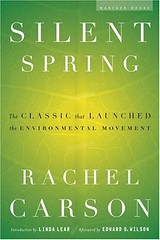 Silent Spring
Silent Spring
Rachel Carson
![]()
Rachel Carson’s Silent Spring was a controversial book in its day; it has remained so in conservative quarters. I sat down to read it with the intention of writing a banned book review, as I have with other controversial books. This is my first reading of Silent Spring, even though it was a hugely influential and popular book in my high school and college years.
Rachel Carson, already a published and popular author, knew Silent Spring would be opposed by many; she initially hesitated to publish it. She had sent advanced copies to scientists she knew, though, and they encouraged her to go ahead. On the eve of the book’s publication in 1962, a leading chemical company involved in the production of DDT threatened to sue Houghton Mifflin, her publisher; The New Yorker, which planned to serialize Silent Spring in its pages; and the Audubon Society, which planned to publish excerpts in its magazine. Rachel Carson herself was vilified, depicted on one hand as a communist propagandist working on behalf of the USSR to undermine the USA, on the other as a dotty spinster and crazy cat lady.
She was called to testify before a senate subcommittee, where she stood her ground on live TV in spite of the fact she was dying of cancer, gaining the admiration of the public and also President Kennedy. The book was published and serialized in spite of chemical company threats, and got a further boost when it became a Book of the Month Club selection. It sold over two million copies and had an Uncle Tom’s Cabin-style effect on America and the West, credited with the banning of DDT and with inspiring an environmental movement that has changed our relationship with nature.
Silent Spring has never, to my knowledge, been challenged or banned in American schools, though it would not surprise me to learn it has been banned or suppressed in other countries.
Reading Silent Spring today, long after the controversy has faded, long after it awakened us to the dangers of pesticides and DDT, is largely an academic exercise. I’m a great fan of popular environmental writing: Marc Reisner’s Cadillac Desert, for example, an alarming nonfiction study of what we’re doing to the American Southwest; or the environmental science fiction of Paolo Bacigalupi. But Silent Spring, which I undoubtedly would have devoured had I picked it up in high school or college, was hard going for me today.
Silent Spring is not a book to be read with pleasure. Carson’s writing is scholarly to a fault. She lays on the facts and figures, but fails to make her silent springs come alive, at least in my imagination. She writes like a forensic examiner, dispassionately describing the careful dissection of a corpse.
I kept putting Silent Spring aside and coming back to it later, finally admitting to myself I was bored with it: maybe because when I became environmentally aware in the 1970s, Silent Spring had already made its mark—DDT had been outlawed in the US, pesticide use was a known evil, and efforts were underway to clean our rivers and streams. Rachel’s warnings had long been heeded by responsible members of government and society. I grew up on her ideas, though I’d never actually read her famous book.
In the end, I was unable to progress beyond the mid-point of this important and influential book. That is entirely on me. I can’t stress enough how important Silent Spring was at the time, or the impact it had on science, agriculture, and society. My own environmental views were molded by it. But I can’t generate the enthusiasm required to plow through this densely-written scholarly study today.
 The Man Who Mistook His Wife for a Hat and Other Clinical Tales
The Man Who Mistook His Wife for a Hat and Other Clinical Tales
Oliver Sacks
![]()
Last year, upon his death, NPR aired some old interviews with Oliver Sacks. In those interviews, he was fascinating and warm, the sort of person I could listen to forever. I had never read him, so I immediately reserved a copy of The Man Who Mistook His Wife for a Hat at my local library.
I’m sad to say I was disappointed in the book and did not finish reading it. Oliver Sacks on paper is not the same man I heard on the radio; his warmth and infectious curiosity is strangely missing. I read four or five of the case studies that make up the book and found them dry and uninteresting.